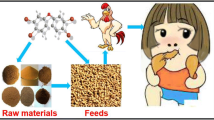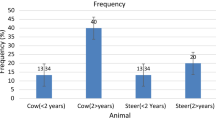Abstract
The dominant part of PBDEs residue in pig tissues was BDE-47 accounted for 48.2% ~ 66.9%, followed by BDE-99 from 15.9% to 24.2%. When the data were on lipid weight basis, the ∑PBDEs concentrations in tissues of individual pig showed the same order of liver > muscle, intestine > fat. Principal component analysis and PBDE congener mean concentration ratios of muscle versus liver (M/L), fat versus liver (F/L) and intestine versus liver (I/L) showed the higher accumulation ability of PBDEs in liver than in other tissues. And the PBDE mean concentration ratios of M/L, F/L and I/L had the trend of decrease with increasing bromination degree of PBDE congeners.



Similar content being viewed by others
References
Bi XH, Qu WY, Sheng GY, Zhang WB, Mai BX, Chen DJ, Yu L, Fu JM (2006) Polybrominated diphenyl ethers in South China maternal and fetal blood and breast milk. Environ Pollut 144:1024–1030
D’Silva K, Fernandes A, Rose M (2004) Brominated organic micropollutants—igniting the flame retardant issue. Crit Rev Environ Sci Tech 34:141–207
Darnerud PO, Eriksen G, JÓhannesson T, Larsen P, Viluksela M (2001) Polybrominated diphenyl ethers: occurrence, dietary exposure and toxicology. Environ Health Persp 109:49–68
Dye JA, Venier M, Zhu LY, Ward CR, Hites RA, Birnbaum LS (2007) Elevated PBDE levels in pet cats: sentinels for humans? Environ Sci Technol 41:6350–6356
Hites RA (2004) Polybrominated diphenyl ethers in the environment and in people: a meta-analysis of concentrations. Environ Sci Technol 38:945–956
Huwe JK, Larsen GL (2005) Polychlorinated dioxins, furans, and biphenyls, and polybrominated diphenyl ethers in a u.s. meat market basket and estimates of dietary intake. Environ Sci Technol 39:5606–5611
Huwe JK, Smith DJ (2007) Accumulation, whole-body depletion, and debromination of decabromodiphenyl ether in male sprague-dawley rats following dietary exposure. Environ Sci Technol 41:2371–2377
Law RJ, Allchin CR, de Boer J, Covaci A, Herzke D, Lepom P, Morris S, Tronczynski J, de Wit CA (2006) Levels and trends of brominated flame retardants in the European environment. Chemosphere 64:187–208
Li K, Fu S, Yang ZZ, Xu XB (2008) Composition, distribution and characterization of polybrominated diphenyl ethers (PBDEs) in the Soil in Taiyuan, China. Bull Environ Contam Toxicol 81:588–593
Luo XJ, Liu J, Luo Y, Zhang XL, Wu JP, Lin Z, Chen SJ, Mai BX, Yang ZY (2009) Polybrominated diphenyl ethers (PBDEs) in free-range domestic fowl from an e-waste recycling site in South China: Levels, profile and human dietary exposure. Environ Int 35:253–258
Mörck A, Hakk H, Örn U, Klasson WE (2003) Decabromodiphenyl ether in the rat: absorption, distribution, metabolism, and excretion. Drug Metab Dispos 31:900–907
Ohta S, Ishizuka D, Nishimura H, Nakao T, Aozasa O, Shimidzu Y, Ochiai F, Kida T, Nishi M, Miyata H (2002) Comparison of polybrominated diphenyl ethers in fish, vegetables, and meats and levels in human milk of nursing women in Japan. Chemosphere 46:689–696
Toms LML, Harden F, Paepke O, Hobson P, Ryan JJ, Mueller JF (2008) Higher accumulation of polybrominated diphenyl ethers in infants than in adults. Environ Sci Technol 42:7510–7515
Acknowledgments
This study was financially supported by the National Natural Scientific Foundation of China (No. 20707031), the National Basic Research Program of China (973 Program) (2003CB415005) and the Knowledge Innovation Program of Chinese Academy of Sciences(KZCX2-YW-420-3).
Author information
Authors and Affiliations
Corresponding author
Rights and permissions
About this article
Cite this article
Li, Y.F., Yang, Z.Z., Wang, C.H. et al. Tissue Distribution of Polybrominated Diphenyl Ethers (PBDEs) in Captive Domestic Pigs, Sus scrofa, from a Village Near an Electronic Waste Recycling Site in South China. Bull Environ Contam Toxicol 84, 208–211 (2010). https://doi.org/10.1007/s00128-009-9922-2
Received:
Accepted:
Published:
Issue Date:
DOI: https://doi.org/10.1007/s00128-009-9922-2




